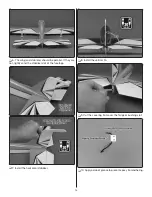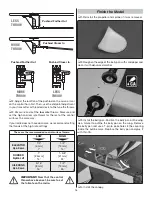
27
Balance the Model Laterally
❏
1. With the wing level, have an assistant help you lift the
model by the engine propeller shaft and the bottom of the
fuse under the TE of the fi n. Do this several times.
❏
2. If one wing always drops when you lift the model, it
means that side is heavy. Balance the airplane by adding
weight to the other wing tip.
An airplane that has been
laterally balanced will track better in loops and other
maneuvers.
Balance the Model (C.G.)
DO NOT OVERLOOK THIS IMPORTANT PROCEDURE.
A model that is not properly balanced may be unstable and
possibly unfl yable.
❏
1. Mark the C.G range location. 2-7/8" to 3-1/2" behind
the leading edge measured at the fuselage.
❏
2. With the plane
ready to fl y
, with an empty fuel tank or
motor batteries installed, use a Great Planes C.G. Machine or
apply narrow (1/16" [2mm]) strips of tape at the front and rear
C.G. locations so you will be able to feel them when lifting the
model with your fi ngers to check the C.G. location.
Do not
at any time balance the model outside this C.G. range
.
❏
3. Use Great Planes “stick on” weight (GPMQ4485) to
balance the plane. Place incrementally increasing amounts
of weight on the bottom of the fuselage over the location
where it would be mounted inside until the model balances. A
good place to add stick-on nose weight is to the fi rewall. Do
not attach weight to the cowl—this will cause stress on the
cowl and could cause the cowl to crack at the screw holes.
Once you have determined if additional weight needs to be
installed, permanently attach the weight with glue or screws
❏
4.
IMPORTANT:
If you found it necessary to add any
weight, recheck the C.G. after the weight has been installed.
PREFLIGHT
Identify Your Model
You should always have your name, address, telephone
number and AMA number on or inside your model. It is
required
at all AMA R/C club fl ying sites and AMA sanctioned
fl ying events. Fill out the identifi cation tag on page 32 and
place it on or inside your model. You must also have your
FAA number on your plane and accessible without any tools.
Charge the Batteries
Always charge your transmitter and receiver batteries the night
before you go fl ying, and at other times as recommended
by the radio manufacturer.
CAUTION:
Unless the instructions that came with your
radio system state differently, the
initial
charge on
new
transmitter and receiver batteries should be done for 15
hours
using the slow-charger that came with the radio
system
. This will “condition” the batteries so that the next
charge may be done using the fast-charger of your choice.
If the initial charge is done with a fast-charger the batteries
may not reach their full capacity and you may be fl ying with
batteries that are only partially charged.
Ground Check and Range Check
Make sure the engine idles reliably, transitions smoothly
and maintains full power indefi nitely. Shut the engine off
and inspect the model closely, making sure all fasteners,
pushrods and connections have remained tight and the hinges
are secure. Follow the radio manufacturer’s instructions to
ground check the operational range of your radio, before
the fi rst fl ight of the day. This should be done once with
the engine off and once with the engine running at various
speeds. If the control surfaces do not respond correctly,
do
not fl y!
Find and correct the problem fi rst. Look for loose
servo connections or broken wires, corroded wires on old
servo connectors, poor solder joints in your battery pack or
a defective battery cell.
Содержание ULTRA SPORT 46
Страница 31: ...Notes 31...






































